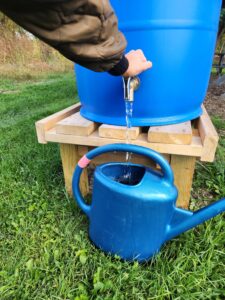


With the goal to create water access for community gardeners during shoulder season months (April/May and October/November) and during climate related stresses like prolonged droughts, Burlington Area Community Gardens (BACG) reinvigorated their water catchment systems at all community garden sites in the Burlington area. On average, the City of Burlington garden maintenance crew turns public access water at community garden sites on by mid May and off by mid October. Although those dates are in place to protect frost-sensitive irrigation infrastructure (nobody likes to deal with frozen pipes!), the water on/off dates don’t align with many gardeners ambitions for season extension. For example, at Seedsong Collective Garden (a VGN program site in the Tommy Thompson Community Garden, at the Intervale), we begin planting in early April and continue harvesting through December. In past years we have carted in jugs of water from early April to mid-May to keep up with watering seeds and young transplants. In November we’ve had to cart in water jugs to finish cleaning tools and watering cold-hardy winter greens. And although we have made it possible (many hands make light work, especially in a collective garden!), we are deeply appreciative of the City of Burlington’s initiative to prioritize rainwater catchment and water storage at all community garden sites.
Another VGN project that has already benefited from rainwater catchment at Tommy Thompson is our recent planting of a 320 sqft perennial garden adjacent to Seedsong. With the help of a volunteer crew, we planted 100+ perennials, including many medicinal, culinary, and native pollinator-friendly plants. Our planting date was on October 16, and especially with this year’s historic drought in mind, we needed to make sure that we would have access to water for watering in the young transplants. The established rain barrels were full of fresh rainwater and we were able to use them to water in the new plants, ensuring their long term success.
Features considered in this pollinator planting included bloom times, flower shapes and nesting habitat. Flowers contain pollen, nectar and eventually, seeds – pollinator food sources – so making sure a pollinator planting has different shaped flowers for different pollinators to access and flowers that bloom all throughout the growing season is crucial to supporting a healthy population. Nesting habitat includes hollowed woody stems, bare ground, and mulch, all of which were included in the design. VGN is particularly excited that many of these plants will be multi functional, supporting pollinators and humans alike. The plants will be accessible to all community gardeners who garden at the Tommy Thompson Community Gardens down at the Intervale so we found it important to choose varieties that could be used by humans while continuing to support pollinators. One example of this is Pycnanthemum muticum (Clustered Mountain Mint), a favorite among a variety of pollinators, a great cut flower when in bloom, and the leaves make a wonderful digestive support and mood boosting tea. Along with other medicinal plants like Achillea millefolium (Yarrow), Hypericum prolificum (Shrubby St. Johns Wort), and Althaea officinalis (Marshmallow), we chose many native varieties such as Liatris spicata (Blazing Star), Symphyotrichum novae-angliae (New England Aster), Solidago caesia (Blue Stemmed Goldenrod) and even some culinary plants like Thymus vulgaris (Thyme) and Allium schoenoprasum (Chives). Each variety is a perennial, meaning it will come back every year. We are so excited to watch this planting get established and continue to evolve.
This planting was made possible with funds from the Conservation Legacy Fund Grant which VGN received from the City of Burlington, and Nora Woolf of Woolf Den Homestead who consulted with VGN and provided a design as well as plants from her plant nursery in Monkton, VT.
